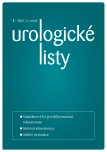The options for surgical treatment of overactive bladder (OAB)
Authors:
A. Čermák
Published in:
Urol List 2008; 6(1): 35-43
Overview
The prevalence of urinary incontinence (UI) and overactive bladder (OAB) increases with age, and elderly people are the fastest-growing segment of the population. Many elderly people believe that UI is a normal part of the aging process and do not see their doctors to discuss the problem. It is up to the physicians to make efforts to obtain objective information about their patients' health problems and their actual health condition. Comorbidity in elderly patients and multiple medications many of them take make diagnosing and treatment more difficult in this population. Just as the etiology of incontinence is often multifactorial, approach to treatment may need to be multipronged and involve behavioural, environmental, and medical components. In any case, it must be targeted to the individual patient. New and less-invasive surgical techniques and devices allow for effective therapy if traditional methods fail.
Key words:
geriatrics, overactive bladder, urinary incontinence
Sources
1. Hampel C et al. Definition of overactive bladder and epidemiology of urinary incontinence. Urology 1997; 50 (suppl 6A): 4-14, discussion 15-7.
2. Krhut J. Hyperaktivní močový měchýř. Praha: Maxdorf 2007.
3. Bojar M, Kučera Z, Svěráková M. Poznámky neurologa o epidemiologii inkontinence v ČR a v Evropě. Proč jsou inkontinence moči a sexuální dysfunkce stále tabu? Inco Fórum, Praha, listopad 2003.
4. Močová inkontinence v ČR. Eklektik Porter Novelli. Praha Stem/Mark 2003 : 2-33.
5. Ehrlich, RM, Gershman A. Laparoscopic Seromyectomy (Bladder Autoaugmentation) for Non-neurogenic Bladder in Child: Initial Case Report. Urology 1993; 42 : 175.
6. Leng WW, Blalock HJ, Fredriksson WH et al. Enterocystoplasty or detrusor myectomy? Comparison of indications and outcomes for bladder augmentation. J Urol 1999; 161(3): 758-763.
7. Swami KS, Feneley RC, Hammonds JC, Abrams P. Detrusor myectomy for detrusor overactivity: a minimum 1-year follow-up. Br J Urol 1998; 81(1): 68-72.
8.DeFoor W, Minevich E, Reeves D et al. Gastrocystoplasty: long-term followup. J Urol 2003; 170(4 Pt 2): 1647-1649; discussion 1649-1650.
9. Ngan JH, Lau JL, Lim ST et al. Long-term results of antral gastrocystoplasty. J Urol 1993; 149(4): 731-734.
10. Bissada SA, Bissada NK. Choice of gastroepiploic vessels for gastrocystoplasty. J Urol 1992; 148(1): 101.
11. Sheldon CA, Gilbert A, Wacksman J, Lewis AG. Gastrocystoplasty: technical and metabolic characteristics of the most versatile childhood bladder augmentation modality. J Pediatr Surg 1995; 30(2): 283 - 287; discussion 287-288.
12. Sumfest JM, Mitchell ME. Gastrocystoplasty in children. Eur Urol 1994; 25(2): 89-93.
13. Cartwright PC, Snow BW. Bladder autoaugmentation: early clinical experience. J Urol 1989; 142(2 Pt 2): 505-508; discussion 520-521.
14. Dewan PA, Stefanek W, Lorenz C, Byard RW. Autoaugmentation omentocystoplasty in a sheep model. Urology 1994; 43(6): 888-891.
15. Dewan PA, Nicholls EA, Goh DW. Ureterocystoplasty: an extraperitoneal, urothelial bladder augmentation technique. Eur Urol 1994;26(1): 85-89.
16. Dewan PA, Stefanek W. Autoaugmentation gastrocystoplasty: early clinical results.Br J Urol 1994; 74(4): 460-464.
17. Atala A. Engineering tissues, organs and cells. J Tissue Eng Regen Med. 2007; 1(2): 83-96.
18. Atala A, Bauer SB, Soker S et al. Tissueengineered autologous bladders for patients needing cystoplasty. Lancet 2006; 367(9518): 1241-1246.
19. Davidsson T, Lindergard B, Mansson W. Long-term metabolic and nutritional effects of urinary diversion. Urology 1995; 46(6): 804-809.
20. Gosalbez R Jr, Woodard JR, Broecker BH, Warshaw B. Metabolic complications of the use of stomach for urinary reconstruction. J Urol 1993; 150(2 Pt 2): 710-712.
21. Smith RB. Use of ileocystoplasty in the hypertonic neurogenic bladder. J Urol 1975; 113(1): 125-127.
22. Küss R, Bitker M, Camey M et al. Indications and early and late results of intestino-cystoplasty: a review of 185 cases. J Urol 1970; 103(1): 53-63.
23. Hendren WH. Reconstruction of previously diverted urinary tracts in children. J Pediatr Surg 1973; 8(2): 135-150.
24. Gearhart JP, Albertsen PC, Marshall FF, Jeffs RD. Pediatric applications of augmentation cystoplasty: the Johns Hopkins experience. J Urol 1986; 136(2): 430-432.
25. Hill DE, Kramer SA. Management of pregnancy after augmentation cystoplasty. J Urol 1990; 144(2 Pt 2): 457-459; discussion 460.
26. Chadwick PJ, Snodgrass WT, Grady RW, Mitchell ME. Long-term followup of the hematuria - dysuria syndrome. J Urol 2000; 164(3 Pt 2): 921-923.
27. Nguyen DH, Bain MA, Salmonson KL et al.The syndrome of dysuria and hematuria in pediatric urinary reconstruction with stomach. J Urol 1993; 150(2 Pt 2): 707-709.
28. Cartwright PC, Snow BW. Bladder autoaugmentation: early clinical experience. J Urol 1989; 142(2 Pt 2): 505-508; discussion 520-521.
29. Cartwright PC, Snow BW. Bladder autoaugmentation: partial detrusor excision to augment the bladder without use of bowel. J Urol 1989; 142(4): 1050 - 1053.
30. Dvořáček J et al. Urologie III. Praha: ISV 1998 : 1618.
31. Penka I. Biofragmentabilní anastomóza GIT - Praha. Praha: Grada Publishing 2004 : 139. 32. Penka I, Šefr R, Kaplan Z, Němec L. Kompresivní anastomosa u akutní resekce tračníku. Rozhl Chir 2000; 79 : 81-83.
Labels
Paediatric urologist UrologyArticle was published in
Urological Journal

2008 Issue 1
Most read in this issue
- Pelvic organ prolapse in women from the viewpoint of a urologist
-
Kolposuspenze dle Burche – zlatý standard v operacích ženské močové inkontinence
Současná urogynekologická operativa I - The Pathophysiology of Large Capacity Bladder
- Urological consequences of gynaecological surgeries
